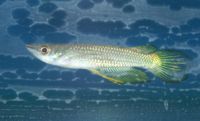Golden Wonder Panchax (Aplocheilus lineatus)
From The Aquarium Wiki
(Redirected from Green Panchax Killi)
Golden Wonder Panchax
Aplocheilus lineatus
150 Litres (39.6 US G.)
7.6-10.2cm (3-4 ")
Freshwater
6.5 - 7.0
20 -25 °C (68-77°F)
7-13 °d
1:2 M:F
2-3 years
Family
Aplocheilidae
This animal is available captive bred
Contents
Additional names
- Striped Panchax, Blue Panchax, Golden Panchax, Golden Wonder, Striped Green Panchax, Sparkling Panchax, Striped Aplocheilus, Green Panchax Killi, Golden Wonder Panchax
Additional scientific names
- Aplocheilus affinis, Aplocheilus vittatus, Haplochilus lineatus, Panchax lineatus, Panchax lineatum
Sexing[edit]
- Males are more brightly coloured than female.
Tank compatibility[edit]
- Can be a community safe fish if kept with the correct tank mates. Be aware that they may become aggressive to other top dwelling fish and can eat smaller fish.
Diet[edit]
- Small insects in the wild. Will take typical frozen small worm food as well as flake and Brine Shrimp.
Feeding regime[edit]
- Feed once or twice a day.
Environment specifics[edit]
- Comes from streams and rivers. Likes wide open, well oxygenated water with space to swim and with floating plants to hide in. Reports of it living to 3 years if kept at the lower end of its temperature range.
Behaviour[edit]
- Primary a top feeder as it looks for insects. Likes to jump so a secure lid is required.
Identification[edit]
- An elongate fish with a slightly upturned snout. The back is olive brown to bronze-brown, and the flanks are bronze to dark forest green in colour. Alternating scales are yellow-gold in colour giving the fish an attractive appearance. These yellow scales continues ant the anal, caudal, and dorsal fins, which are bronze in colour. The jaw and frontal belly regions are yellowish white and the iris of the eye may be green. Nine dark, transverse stripes mark the body of juveniles and mature females. At least two variants are common to the hobby: one with a fully red tail, and the other with the majority of the caudal fin is red, and the outer lobes are white. The anal and dorsal fins are yellow.
